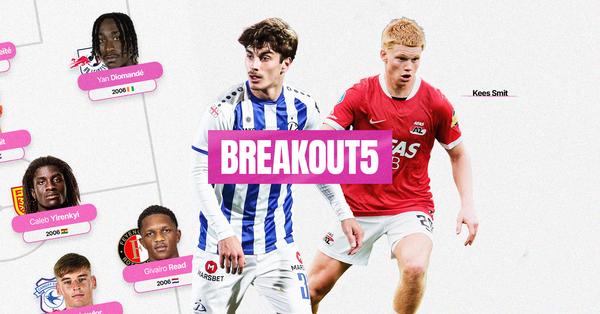South American Supermarket Sweep
How Argentinian clubs can compete with Brazil by investing in idiosyncratic pools of talent across Latin America.
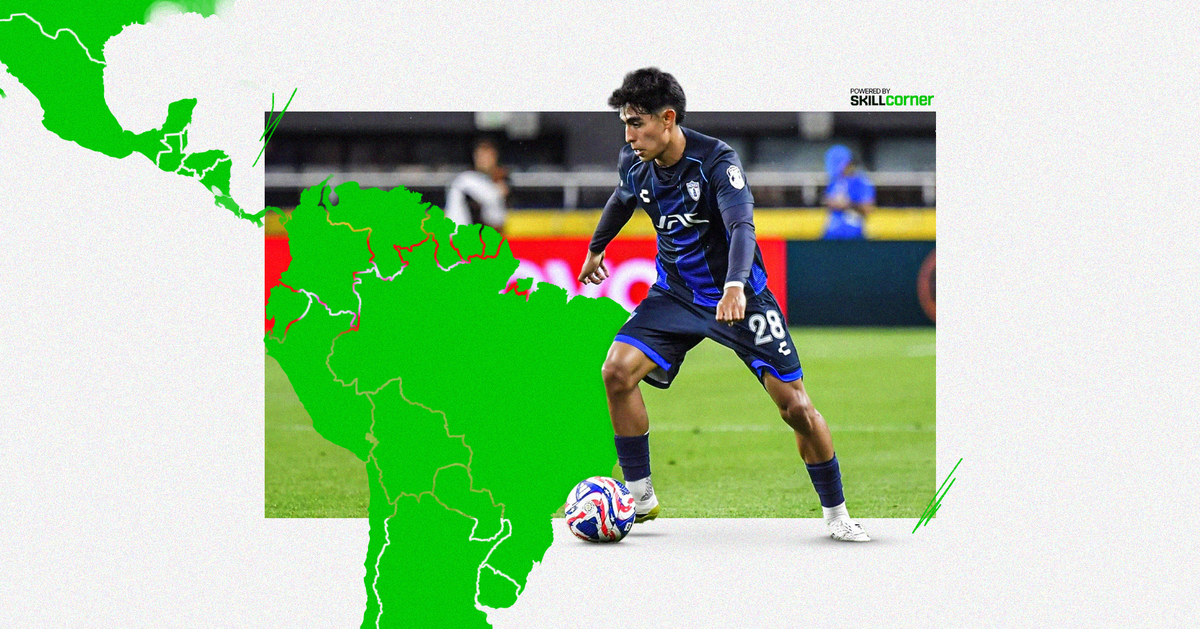
This is not the usual Monday Night SCOUTED newsletter as Jake was invited to attend a match on behalf of SCOUTED this weekend. Instead, we have published his latest SkillCorner analysis: a shopping trip around Latin America.

As of July 2025, the Liga Profesional Argentina was ranked by Opta as the 11th ‘strongest’ league in world football - two places below the Brasileirão.
A Brazilian side has lifted each of the last six Copa Libertadores trophies. Brazil has provided ten of the 12 finalists in that time. Argentina filled the other two spots - River Plate (2019) and Boca Juniors (2023). The gap between the two powerhouse nations of South American football is widening.
Why? That’s best explained by Fernando Romero Nuñez, writing in the Buenos Aires Herald:
The 2025 Liga Profesional champions take home US$500,000, a paltry sum compared to the US$13.8 million paid to the Copa do Brasil winners.
As Brazilian clubs increasingly turn to Europe to flex these finances, their rivals in Argentina are buying heavily from their neighbours: Paraguay, Uruguay and Chile made up the top three for incoming transfers to Argentina in the most recent window.

But the majority of these imports hold little resale value. The average age of Argentina’s incoming transfers is 26.4 - higher than the CONMEBOL average of 25.6 and two years greater than Brazil’s 24.4. Recent economic factors have allowed Argentine clubs to offer larger salaries: a boon they seem keen to spend on older, cult-hero-type journeymen.
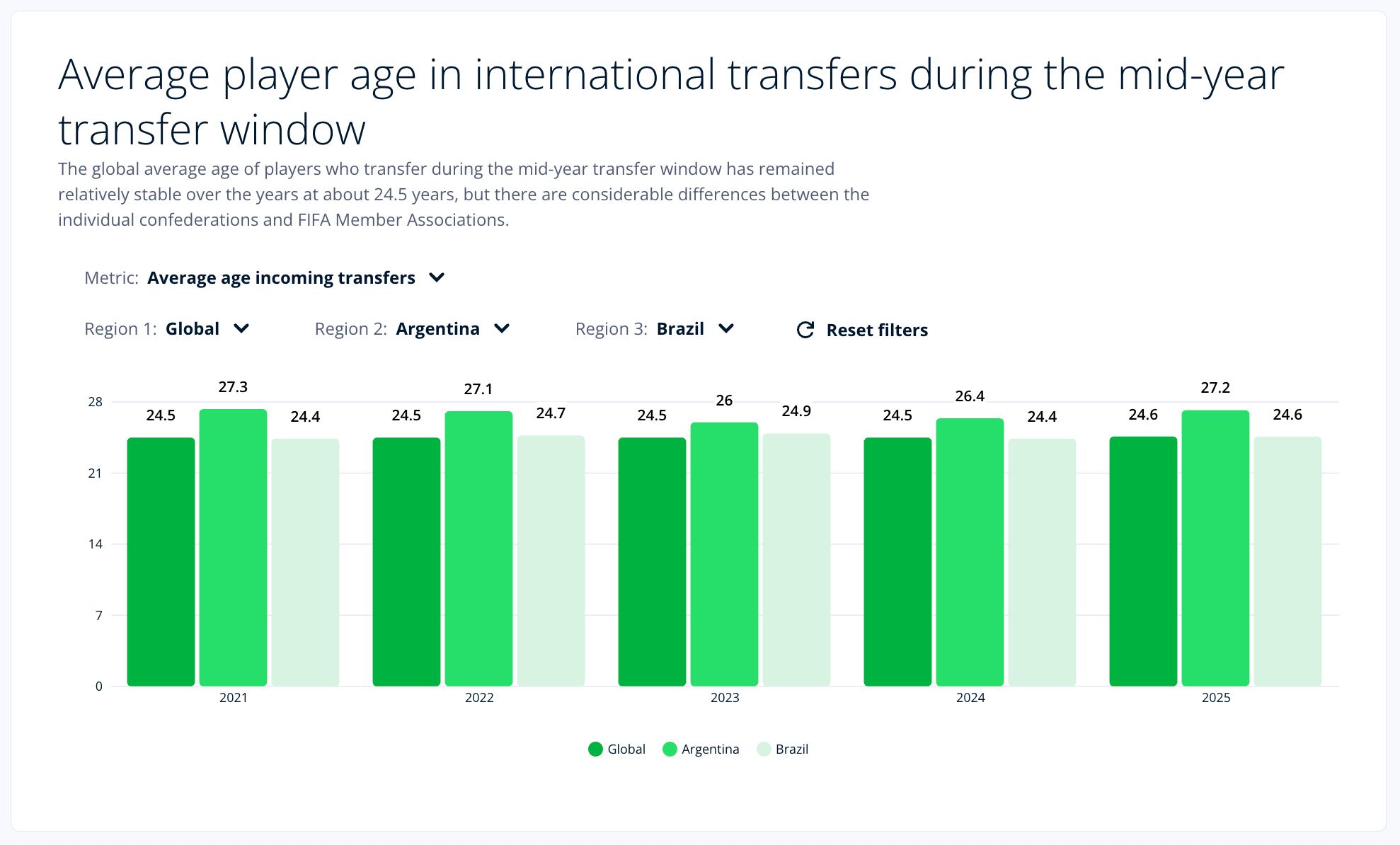
Instead, Argentina have an opportunity to solidify themselves in South America by being more targeted in their existing recruitment - buying players of modern profiles with likely resale value from the countries they’re already looking at - as well as branching out into new, underexplored markets in search of value. With SkillCorner data, we can do both. Let’s go shopping for Argentina.
Writing a list
Where should we start, and what should we be looking for?
The physical output of nine divisions in the Americas immediately highlights two areas of interest. Colombia’s Categoría Primera A is the quickest and most explosive league while Chile’s Primera División is top for Distance for Running, High Speed Running and Sprint bands.
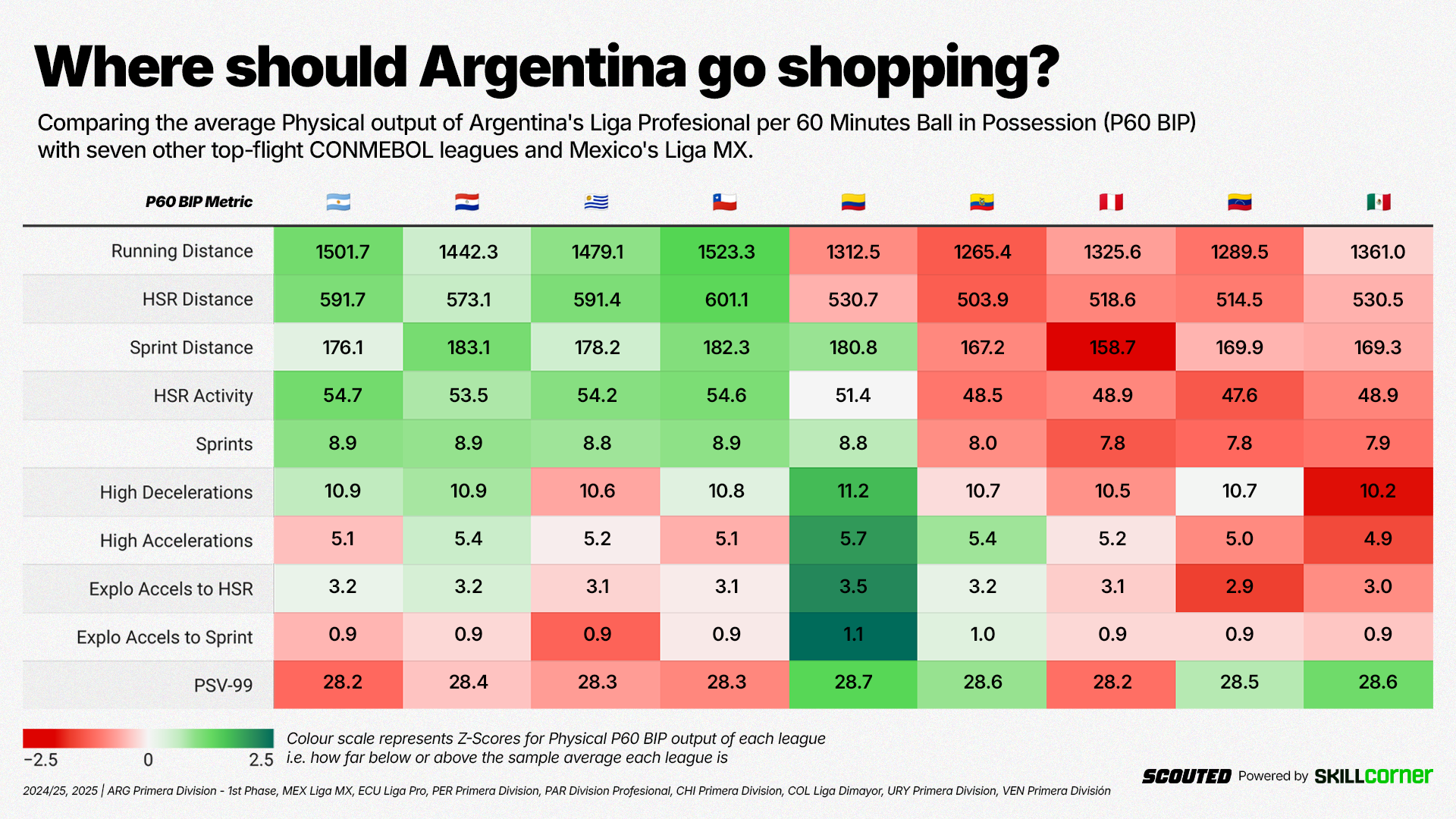
This suggests we should look for a Roadrunner winger in Colombia and a ground-eating midfielder in Chile. We’ll add both to our shopping list. These are the markets Argentinian clubs are already buying from - where else in South America contains specific value?
As we’ve done before, we can use international poster boys as inspiration for profiles a country might be abundant in. For example, three of Uruguay’s top five most valuable players are central midfielders: Federico Valverde, Manuel Ugarte and Rodrigo Bentancur. The famous garra charrúa appears to give these midfielders limitless stamina. So let’s pair Uruguay and Chile together for the ground-eater search.
Another emerging national profile is the Ecuadorian centre-back. Willian Pacho, Piero Hincapié and Joel Ordóñez are all graduates of the famous Independiente del Valle academy and have all had a year to remember. Scouring Ecuador for the next in line is a must.
Finally, a trip to Mexico is in order. This year’s U-20 World Cup squad dominated Brazil in the group stage and rescued a draw against Spain. At the heart of it is 16-year-old wonderkid Gilberto Mora. He is extremely Pedri-coded; it’s worth checking for other Mexican technicians worth investing in.
So, here is a recap of our list:
Let's go shopping.
The Ground Eater
Finding a box-to-box midfield dynamo in Chile and Uruguay
To create the Ground Eater Player Index on the SkillCorner Lab, I combed through the output of midfielders I personally associate with this role - including our Uruguayan inspiration Fede Valverde - in order to discover the key Phases of Play and Possession metrics to pair with our Physical data points.
In particular, Carries at Speed emerged as a core Possession metric for this profile, so I weighted this most heavily. The Index also includes Recovery Press Engagements Per 30 OTIP and Got Goal Side Percentage to help build a profile that maps a two-way midfielder capable of driving the ball forward but also proficient at sprinting back the other way.
When applying this new Player Index to U23 midfielders across Chile and Uruguay’s top-flight, a clear primary target emerged. Ignacio Sosa Ospital, to give his full name, is a 2003-born midfielder that plays for Club Atlético Peñarol in the Uruguayan Primera División. Rather serendipitously, that’s the same club from which Real Madrid signed Valverde.
Sosa was the highest-scoring Ground Eater within the U23 midfield search and looking under the hood makes it clear why.
First, it’s worth noting that for pure Physical output, the top result was from Chile: 2004-born Bastián Silva has an arresting profile. But Sosa is no slouch in comparison; The Uruguayan is in the top 10% across both leagues for Sprint Distance and PSV-99.

Looking at Off-Ball Profiles, although Sosa does not match Silva for Runs in total, they both rank in the top 10% for the Developer Runs we associate with Midfielders that look to achieve progression through their off-ball movement: Runs Ahead of the Ball, Overlap Runs and Underlap Runs.

In terms of Possession metrics, Sosa’s top 5% ranking for Carries At Speed and Forward Momentum continue to match our criteria of a relentless runner with limitless stamina. These Possession metrics are what separate him from Silva.
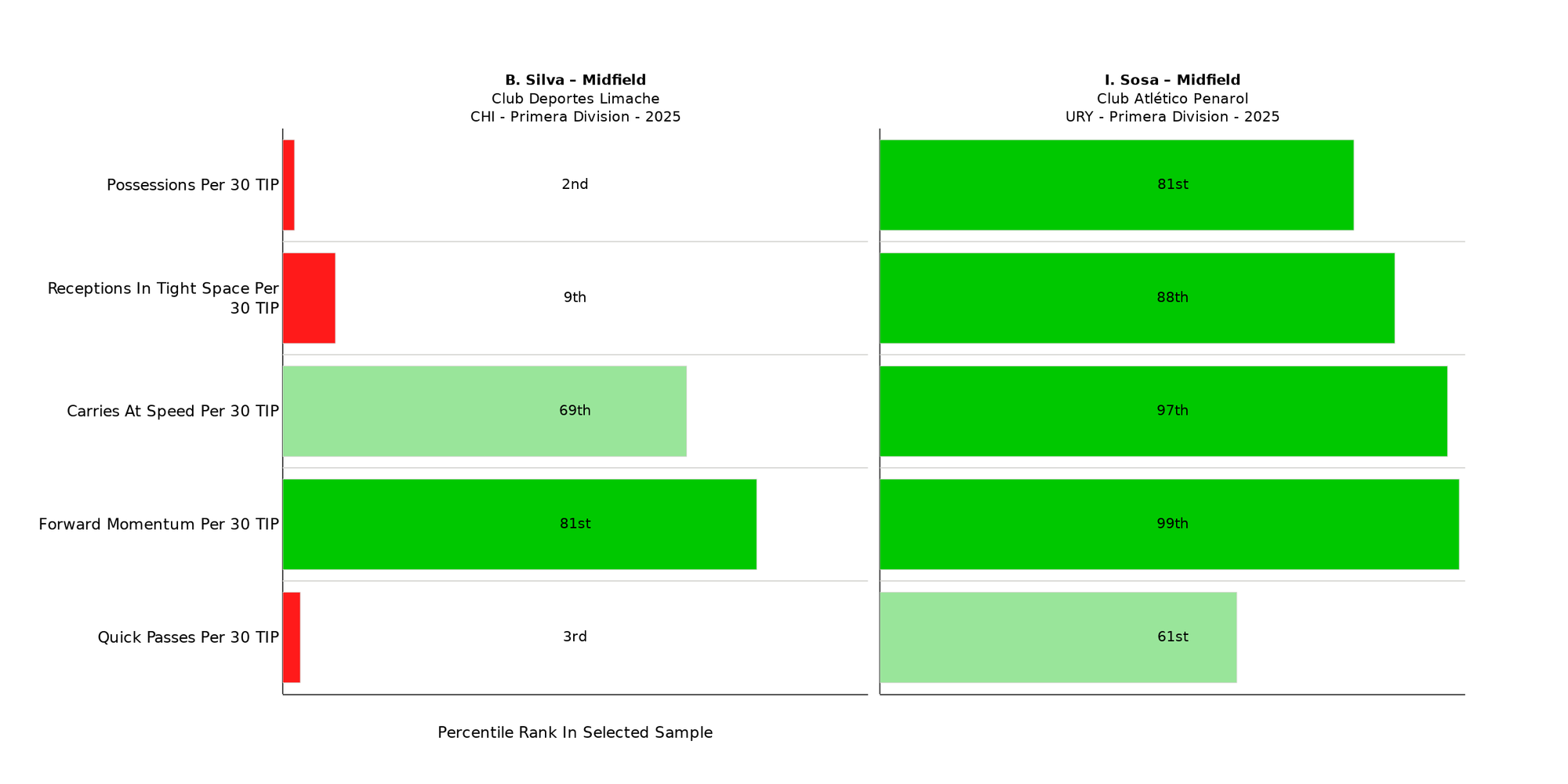
Although the top-scoring Ground Eater for this search, Sosa’s On-Ball Engagements and Outcomes did not match the Index to a tee. Rather than Recovery Press, the Uruguayan ranked higher for Counter Press Engagements - valuable, but different.
That being said, he still ranks well for Got Goal Side and Got Close percentages which speak to his efficiency at covering and closing distance when required.
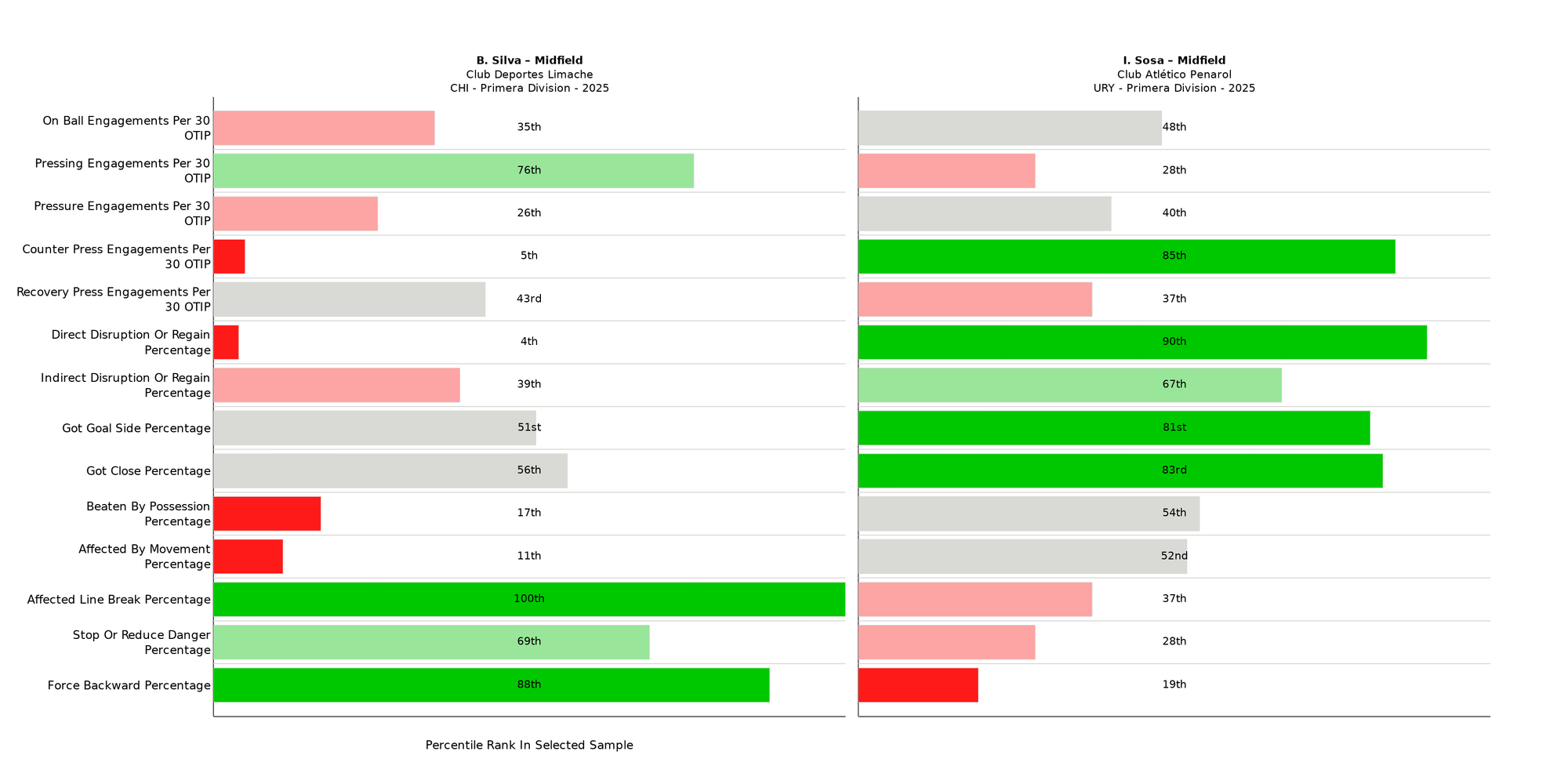
Now, let’s add the Argentina Primera División into our sample and expand to all ages to see how Sosa and Silva stack up. By plotting Carries At Speed Per 30 TIP alongside the Ground Eater Player Index, we can hone in on that key metric.
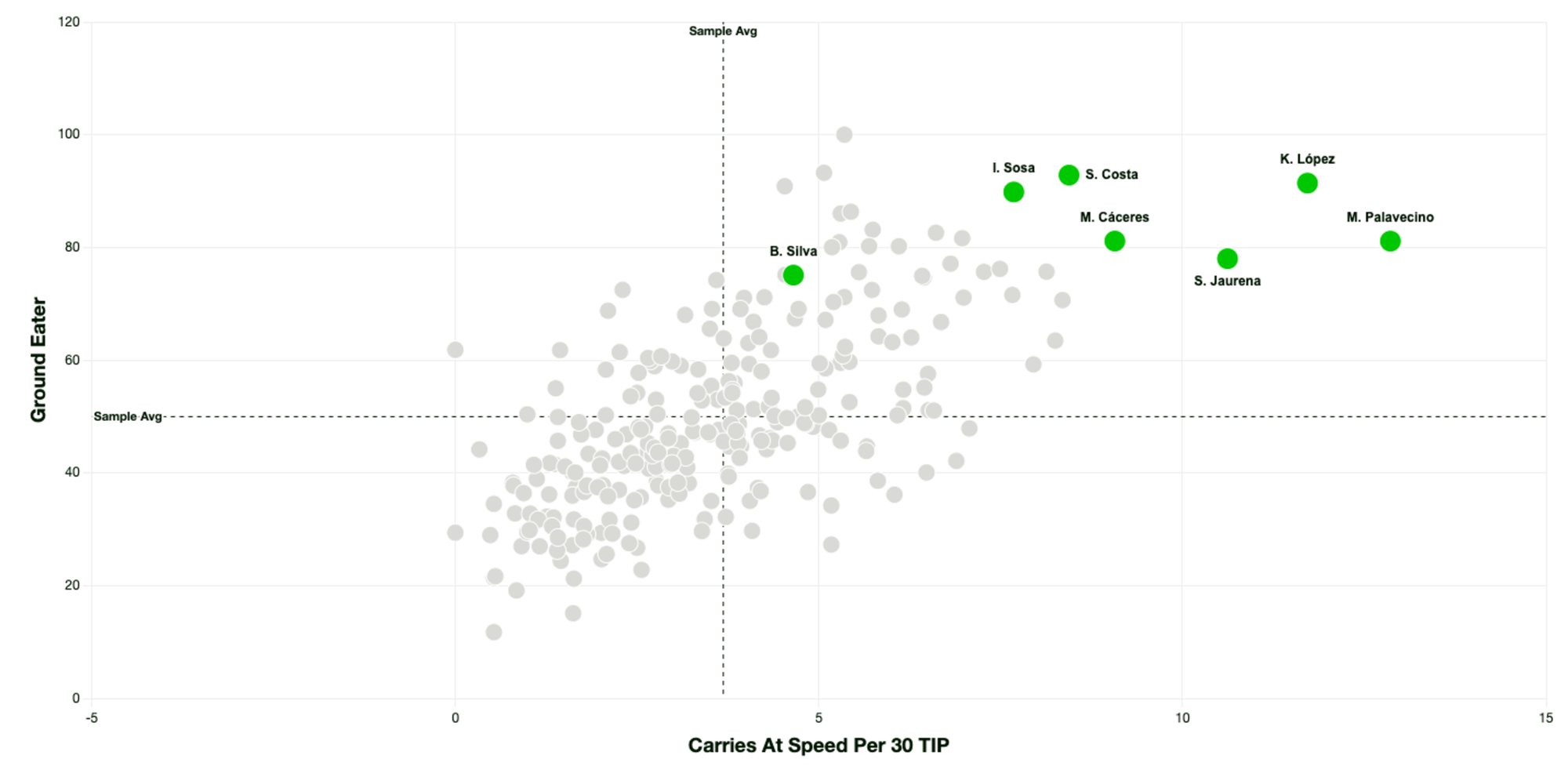
Silva still scores well as a Ground Eater due to his monster Physical output but falls away for our core datapoint. Sosa, meanwhile, ranks 6th on the Ground Eater Player Index - the only Midfielder from the Uruguayan Primera División ranked higher is 2000-born Santiago Costa - and separates from the sample by ranking 10th for Carries at Speed.
Peñarol signed Sosa from CA Fénix in July 2023 for €629k, according to Transfermarkt. If an Argentinian club is to make a move, they need to do so soon. Multiple reports suggest that Red Bull Bragantino are already negotiating with Peñarol. With Uruguay head coach Marcelo Bielsa raving about him in press conferences, they might not be the last club to make an enquiry.
With Ignacio Sosa added to the cart from the Ground Eater aisle, let’s see what Colombia has to offer.
The Roadrunner
Finding an explosive winger in Colombia
When comparing the Physical output of each league, Colombia ranked first for High Accelerations, High Decelerations, Explosive Accelerations to Sprint, Explosive Accelerations to HSR and PSV-99. In fact, the Z-Scores for the two Explosive Acceleration metrics were the highest of the entire comparison. Naturally, they became a core part of our new Player Index.
In total, 10 players under the age of 23 appeared in our search when looking for left and right Wide Attackers in Colombia in 2025. The below table shows their league-wide percentile ranking for each metric used in the Roadrunner Player Index as well as their composite score for that profile.

The first order of business is to declare that Botafogo have already taken Jordan Barrera off the market. The reigning champions of Brazil signed the Colombian in July this year so Argentinian clubs can forget about him. Despite having fingers in European pies, Brazilian clubs are very much still frequenting the South American aisles.
Meanwhile, Yeicar Perlaza has recorded a faster PSV-99 than all 56 Wide Attackers in Colombia’s Liga Dimayor this year. His combination of speed, explosive bursts and a cross-first mentality paints the picture of an orthodox winger. The fact he has also deployed at right-back and right-wing back suggests he is a straight-line threat. Option one.
Carlos Torres and the fantastically named Beckham Castro are the only players that rank in the top 10% for both Explosive Acceleration metrics. But they are completely different players.
Three players, three profiles - let’s sort between them to find our buy.
Beckham, unlike his legendary namesake, uses his explosiveness to become a constant Off-Ball threat. He ranks first for Runs In Behind among all Wide Attackers in Colombia’s top-flight this year and is approaching the top 10% for Cross Receiver Runs. Torres is an outlier for Build-up Runs such as Dropping Off and to a lesser extent, Pulling into the Half-Space instead. Although it’s important to stress this does not mean they happen in the Build-up phase.
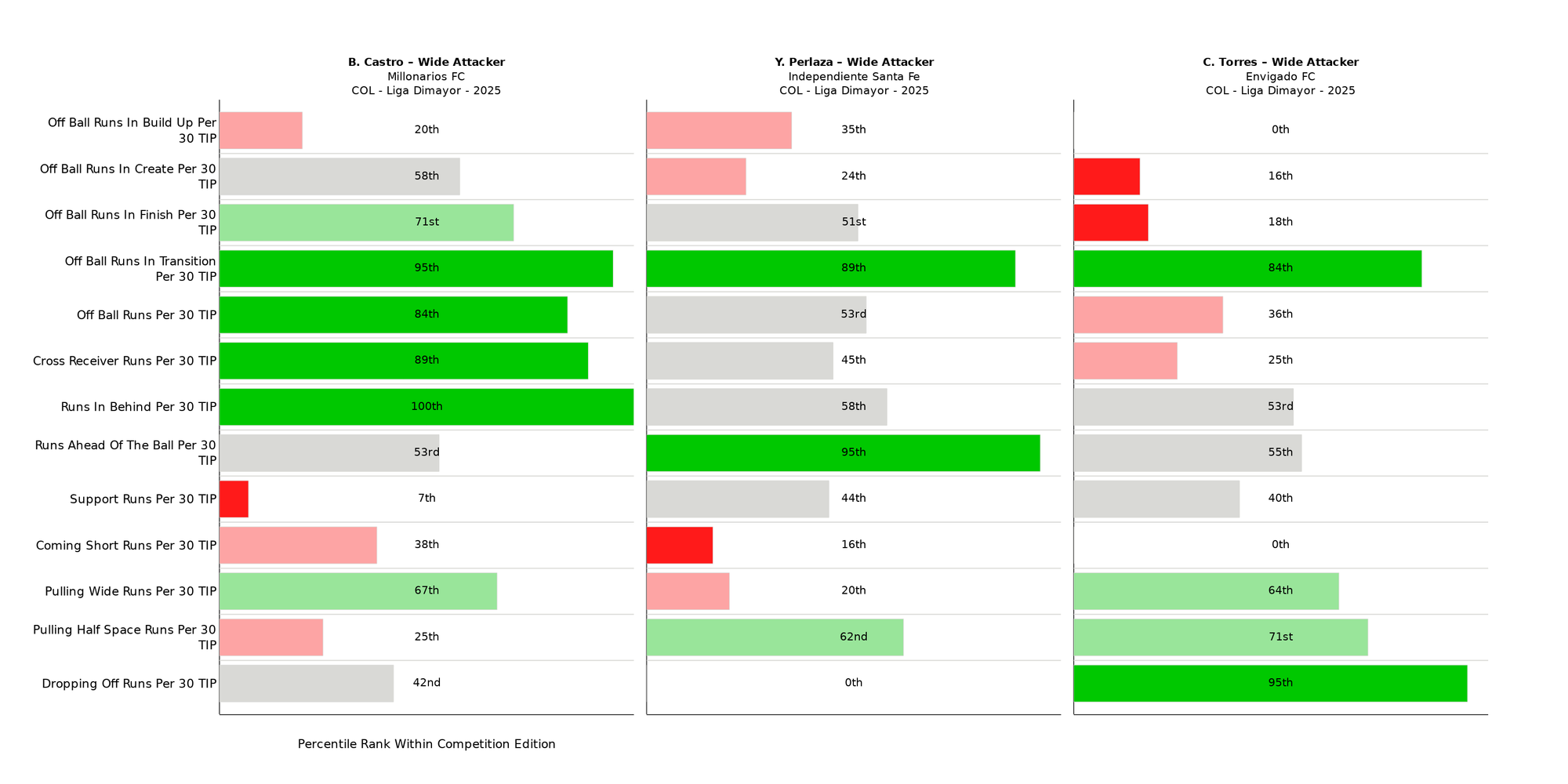
As you might expect from a trio of rocketed-boosted wingers, they all make lots of Runs in Transition. Beckham’s penchant for Direct Runs means that he is usually latching onto passes in this phase. As a result, he ranks last for Carries At Speed among our under-23 wingers, - which is perfectly fine considering we have identified off-ball running as his main product. Torres, however, ranks first for this metric and is also more likely to receive the ball in Tight Space.
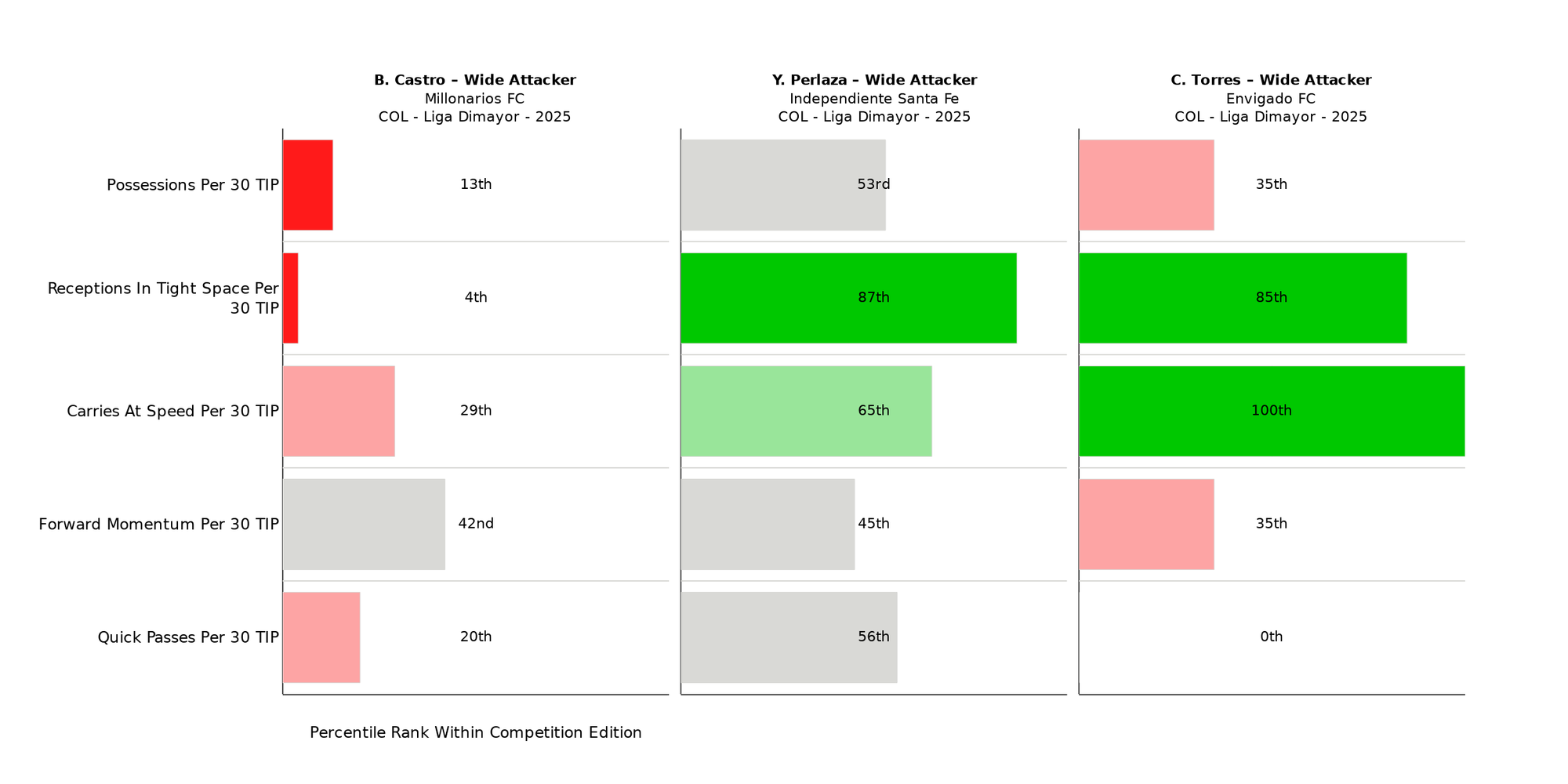
It appears that while Beckham uses his explosive speed to threaten the most dangerous areas of the pitch by running without the ball, Torres looks to receive before exploding past opposition players and moving towards goal himself. Meanwhile, Perlaza’s accelerations lead to ambitious and speculative crosses - a style more befitting of the Beckham name.
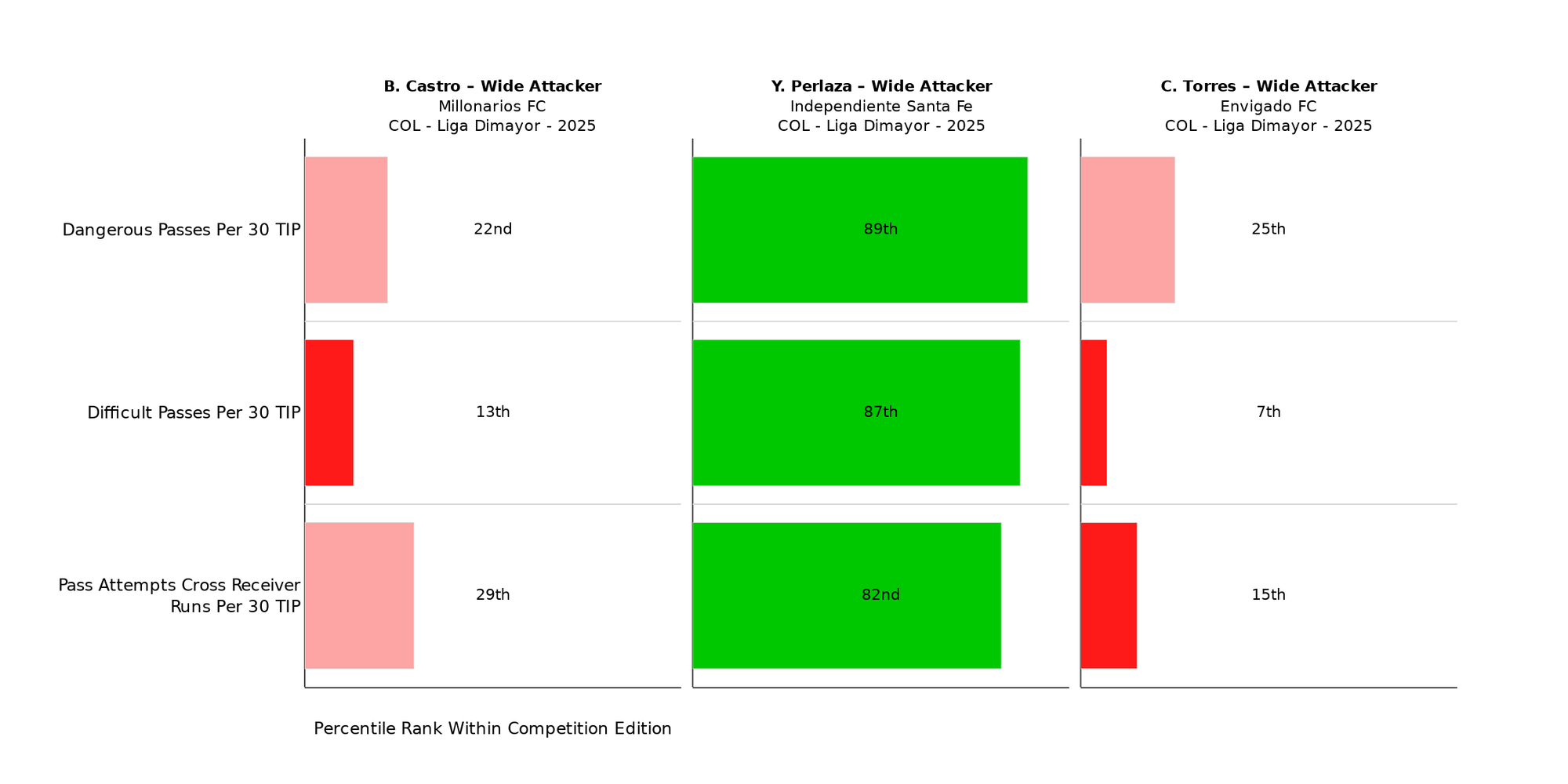
The final contrast between these three is their appetite for pressing. Although not part of our Roadrunner search, it’s interesting that Torres’ explosive athleticism appears to have transformed him into a menace out of possession while Beckham provides very little support. Perlaza is a more rogue. While Pressing Engagements measure On Ball Engagements as part of a pressing chain, Pressure Engagements measure individual OBEs.

Across all ages for Wide Attackers in Colombia and Argentina, Torres ranks fourth for the Roadrunner Player Index and third for Explosive Accelerations to Sprint. Interestingly, the only player aged 23 or under to rank above him is Alejandro Piedrahita, who just so happens to be on loan to Gimnasia in Argentina from Colombian side Deportivo Pereira. Faber Gil, who also plays in Colombia, is the only player that ranks ahead of him for both metrics.
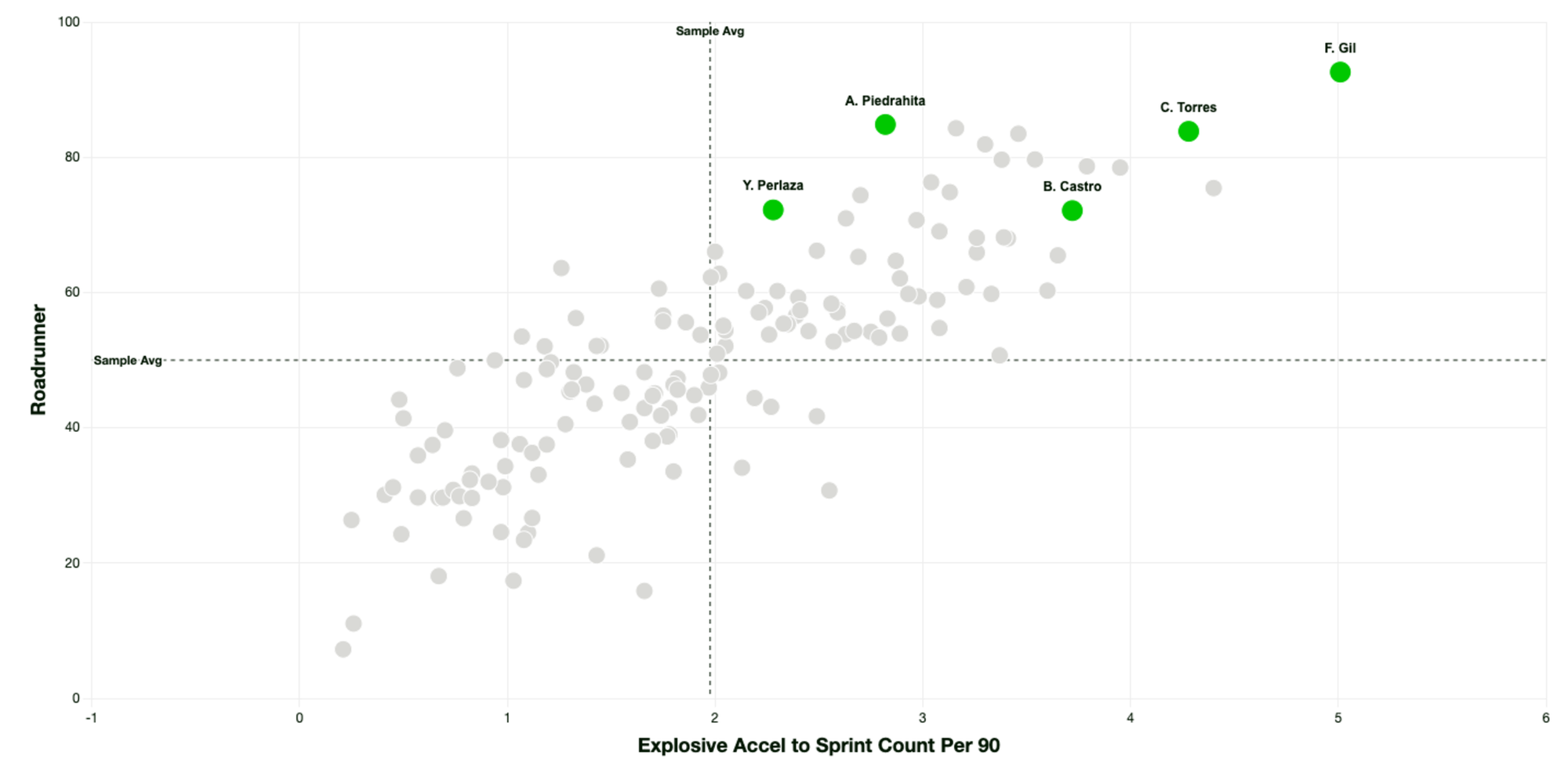
All three wingers are explosive, but which player we add to the cart depends on who we’re buying for, and that team’s particular stylistic needs. If you want a touchline-hugging, cross-whipping winger-cum-wing-back, sign Perlaza. If you want a relentless off-ball threat in behind, sign Beckham.
For our Roadrunner search, though, we’re plonking Carlos Torres on the list. His propensity to carry the ball at speed leans into that style - imagine him saying ‘Meep! Meep!’ as he flies past opposition full-backs. The added bonus of his explosive pressing makes him a unique pick. Next stop, Ecuador.
The Sentinel
Finding a centre-back prospect made for modern football in Ecuador
I name-checked Willian Pacho and Piero Hincapié when introducing the emerging trend of elite Ecuadorian centre-backs. Let’s first compare these two players with the Player Index I used to scout for the next in line.
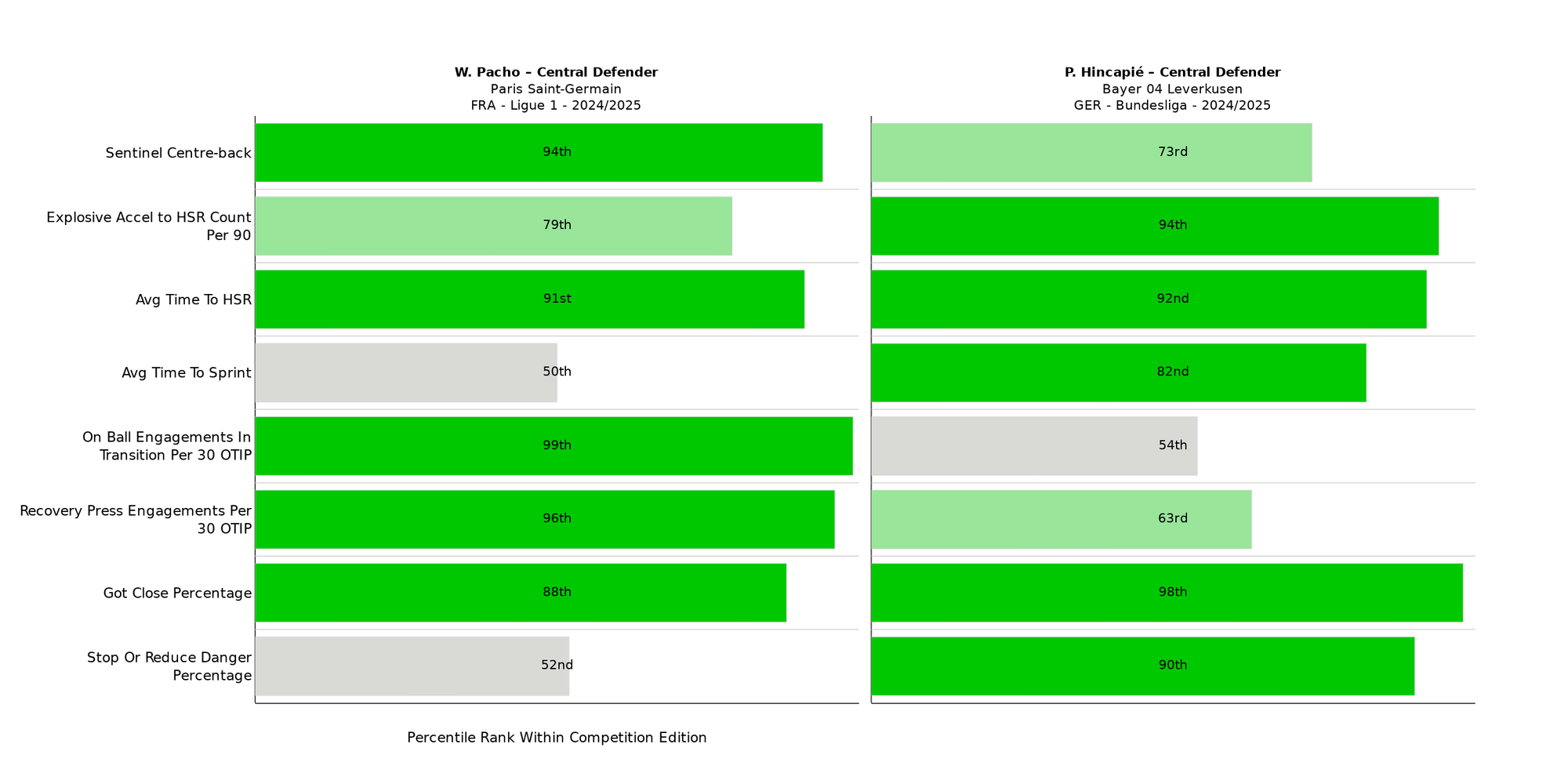
The ability to deal with transitions scales to the elite level, so this profile focuses on proficiency in doing so. Pacho is testament to that as PSG’s dominance plays into his top 5% rankings for OBE In Transition and Recovery Press Engagements.
Time to HSR and Explosive Accelerations to that speed band emerged as good physical traits to augment this profile, while the ability to Get Close and Stop or Reduce Danger is a great way to ensure we flag players not currently exposed to the same volume of transitions as Pacho but could be as proficient in doing so.
When looking at the 2025 Liga Pro season, just six centre-backs aged 23 or under meet the required performance count threshold. We need to pick one.
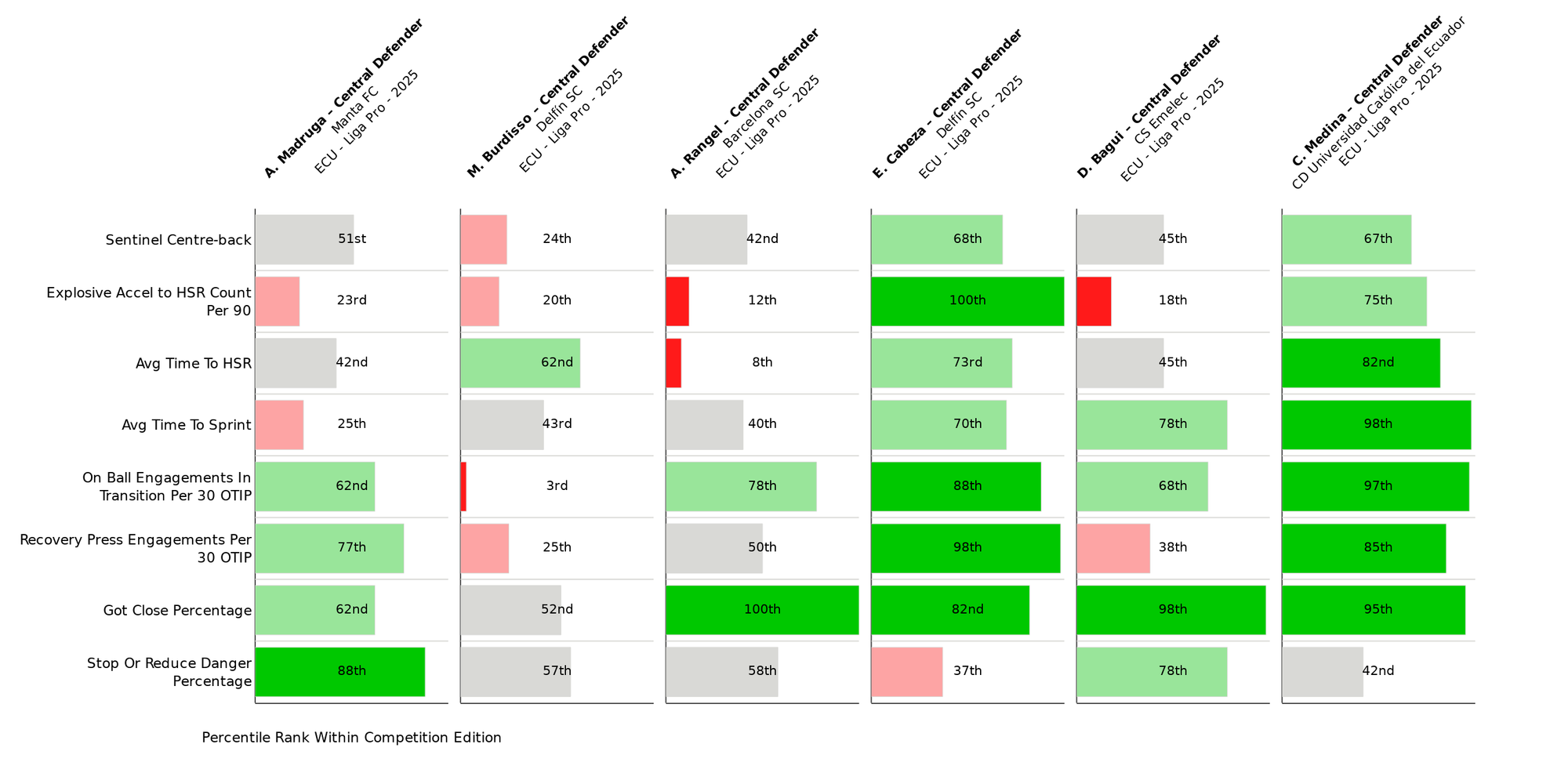
For our particular search, 2002-born Edilson Cabeza and 2001-born Carlos Medina stand out. Cabeza is a stockier (1.82m tall) right-sided defender while Medina is taller (1.9m) left-footer.
The former’s 100m-sprinter-like build may partly explain why he is more often found on the right-side of a back three or even at right-back. He ticks that hybrid box. This role demands more frequent explosions out of the blocks to engage players out wide or even support attacks. We can already see that he ranks first for Explosive Accelerations to HSR but a full Physical breakdown shows he is also in the top 2% for Explosive Accelerations to Sprint.

However, Medina’s Physical output is equally as impressive. His longer legs not only enable him to reach the Sprint band in excellent time - quicker on average than the stockier Cabeza - but he has also averaged the highest PSV-99 among centre-backs in Ecuador’s top-flight. You could argue that, similar to Pacho, his increased exposure to transitions gives him more opportunities to reach high speed over larger distances and get full value from those longer strides.
But a quick peek at On-Ball Engagement Outcomes highlights the value of this speed. Medina is in the top 10% for Got Close and Got Goal Side percentage. Cabeza’s hybrid role, meanwhile, is conducive to a more active OBE output but decreased efficiency.
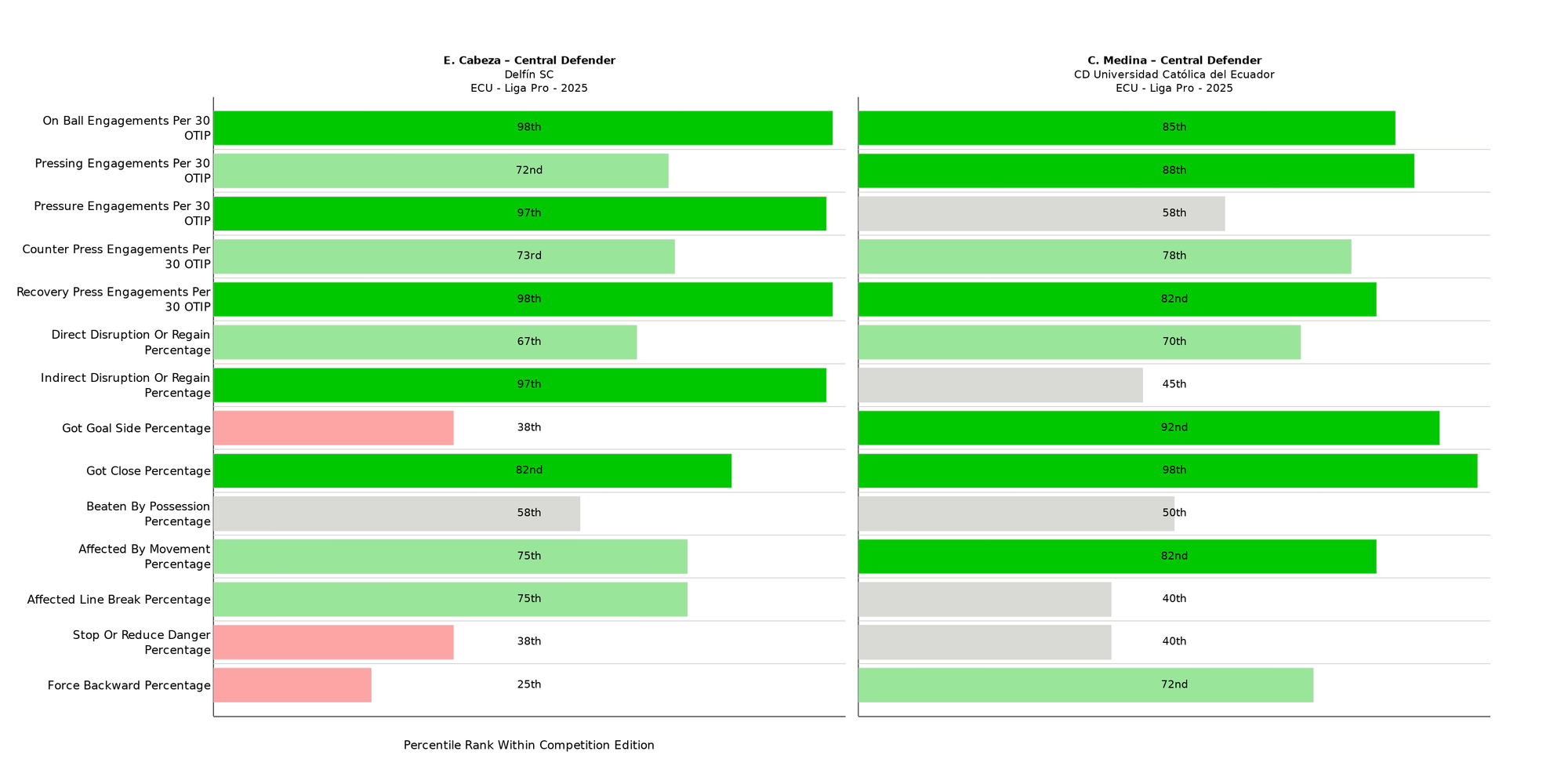
Once again, we have discovered slightly different profiles within the same search. But Ecuador has certainly delivered in its promise of unearthing some meta-sympathetic centre-backs.
When including Argentina’s Primera División and expanding the sample to Centre-backs of all ages, both Cabeza and Medina rank in the top 10 for the Sentinel Player Index. The only other players aged 23 or under to join them are 2004-born Mateo Mendoza (Godoy Cruz) and 2002-born Kevin Lomónaco (Racing Club).

As for the pick, Carlos Medina is already familiar with defending both in higher blocks and in transition while appearing to be very proficient in doing so. He’s going straight in our basket. That leaves one last place to visit.
The Technician
Finding a Pedri-coded contemporary creator in Mexico
The final aisle of this shopping trip is outside of South America but I have included it for good reason. At this year’s FIFA U-20 World Cup, Mexico finished second in a group that included Morocco, Spain and Brazil before knocking out Chile in the Round of 16. They fell to none other than Argentina in the quarter-final, a game in which they controlled possession but could not deal with the speed of thought and fleet of foot in Argentina’s attack. At the heart of Mexico’s sensational run was 16-year-old Gilberto Mora.
His deployment in a free role up top allowed him to display his buttery smooth ball control, intelligent movement, as well as his technical proficiency through the crispness of his passes and finishing. That’s where the Pedri comparisons have come from.
So, given both Mora’s and Mexico’s ability to dictate games against South American sides, Liga MX is worth scouring to see if another Pedri-coded creator is available.
What makes Pedri one of the best midfielders in the world is the modern blend of in-possession mastery and out-of-possession effort. This balance is at the core of the Gameweaver Archetype in development at SCOUTED: a player that contributes to every phase, secures possession, aids progression, seeks penetration and also recovers the ball if it breaks down at any point. It’s a blend of multiple profiles. I have created a Player Index inspired by this to test the waters in Mexico.
It’s worth noting that given Mora’s relative lack of minutes and the spread between Midfielder, Left Wide Attacker and Centre Forward, he does not appear in our 2024/25 Liga MX search. But Mexico’s captain at the U-20 World Cup does.
When sorting all Midfielders by the Pedri-inspired Player Index, not only does Elías Montiel rank fourth outright, he is one of just two players aged 23 or under inside the top 20. The other? Another member of the 2025 U-20 World Cup squad: Iker Fimbres.

Both Montiel and Fimbres have the same Pedri-coded Physical output. Distance covered emerged as a solid metric to separate the static conductors with the playmakers in perpetual motion. These two 2005ers are at the very top.
However Montiel’s potential to fulfil a similarly all-conquering midfield role becomes more obvious when looking at a comparison in radar form. Especially in terms of the tempo-setting forward passing through the lines.
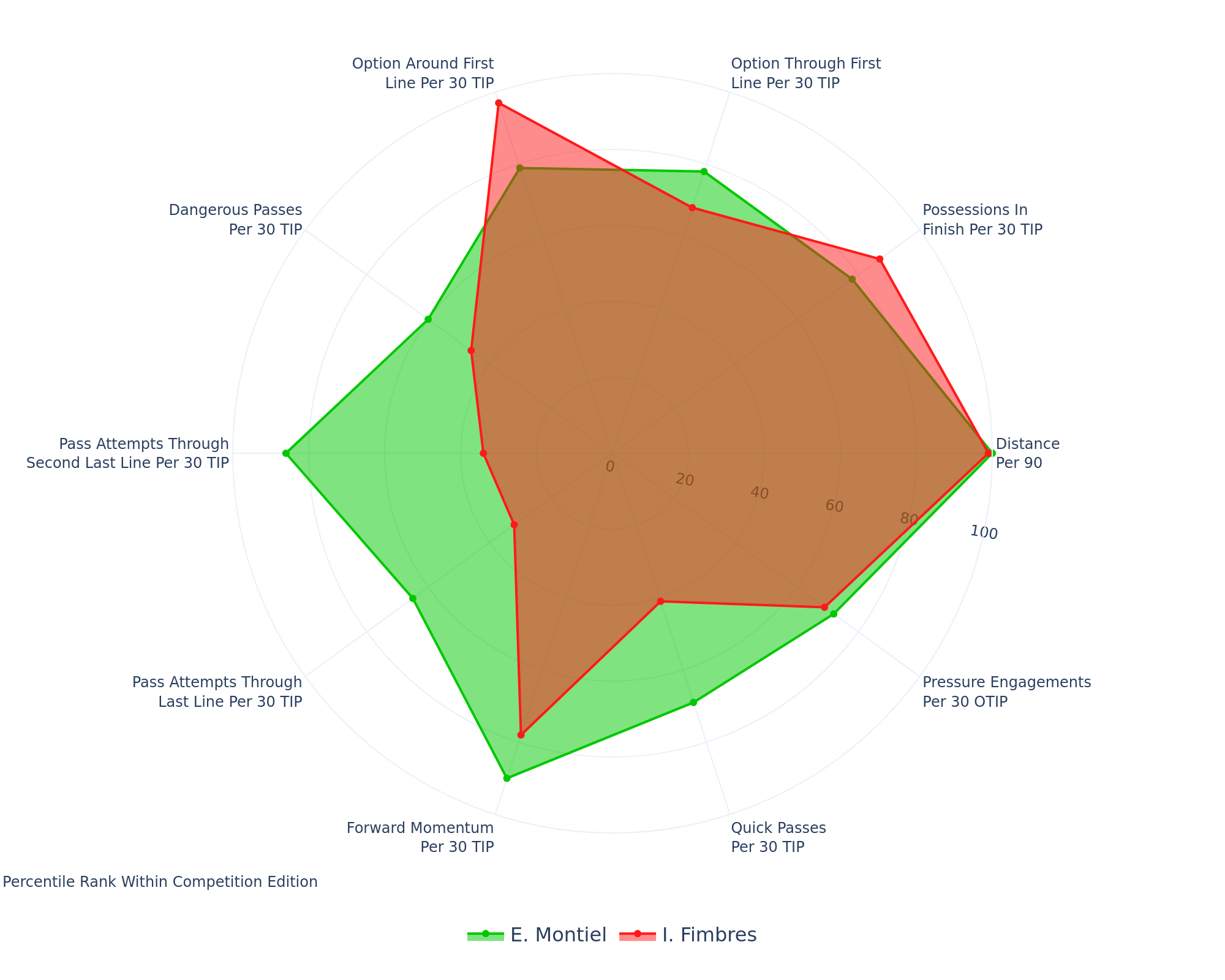
Like Mora, however, Montiel will already be on shopping lists throughout Europe - he’s certainly on ours. As will Boca Juniors 2005-born midfielder Milton Delgado, who faced Mexico in the U-20 World Cup quarter-final and is emerging as the quintessential Platformer.
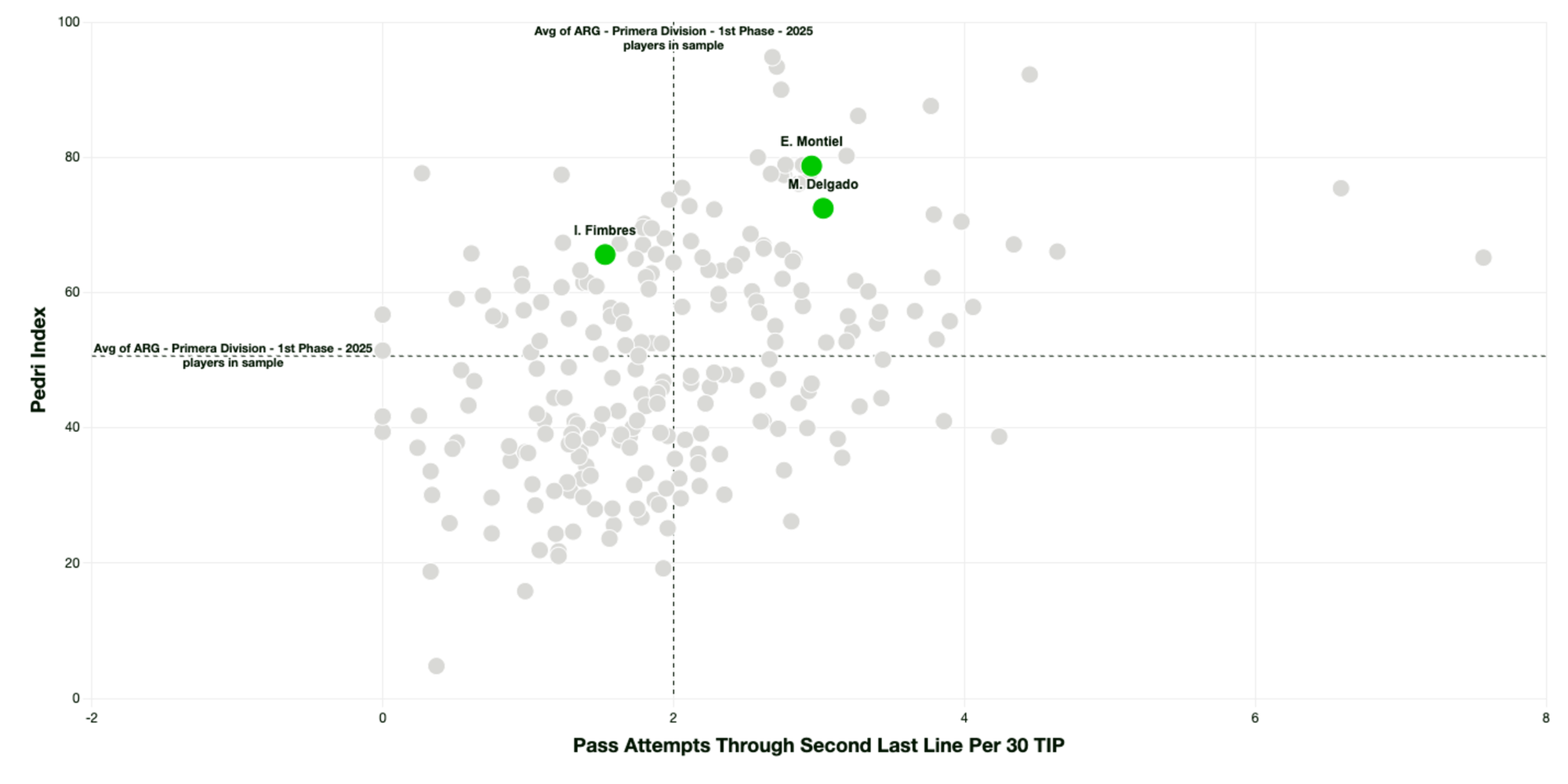
As the world wakes up to an exciting generation of Mexican technicians that can rival their Hispanosphere rivals, Boca may well want to start scouting Liga MX in anticipation of a bid for their own midfield prodigies. There’s no harm in asking Pachuca to name their price for Montiel.
By identifying the idiosyncratic profiles that exist within Latin America, Argentina can supercharge its recruitment. This can be achieved with SkillCorner through two means. The first is by benchmarking the leagues using data from the outset in order to highlight unique qualities; this is how we identified Colombia as a potential hotbed for rocket-boosted wingers.
The alternative is to translate romantic profiles associated with each nation or Archetype poster boys into data points; we created a Player Index inspired by Uruguay’s Garra Charrúa and another based on Pedri.
Using these two techniques, we spotted a bunch of exciting profiles ripe for further investigation but here is the order summary:
- Ground-eating midfielder: Ignacio Sosa Ospital (2003, Peñarol)
- Roadrunning winger: Carlos Torres (2002, Envigado)
- Sentinel centre-back: Carlos Medina (2001, Universidad Católica)
- Gameweaving technician: Elías Montiel (2005, C.F. Pachuca)
Rather than waiting for the likes of Edinson Cavani, Gary Medel and Leandro Paredes to reach their expiry date, the Argentines have a huge opportunity to shop for the freshest iterations instead. By modelling their style into Player Indices and Archetypes, Argentina can discover, develop and sell the next generation of icons - before they hit their peak.
This newsletter was produced under a commercial collaboration with SkillCorner, SCOUTED’s official data partners. Their tracking and performance data is used by more than 150 of the world’s biggest clubs, leagues and confederations.



